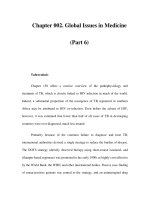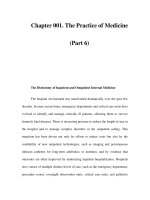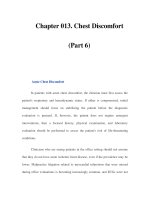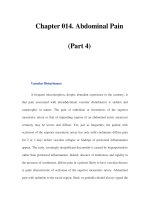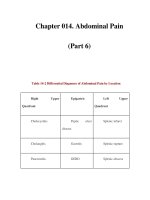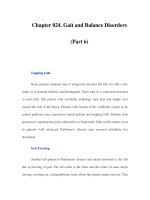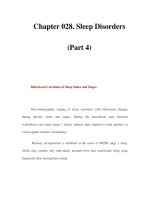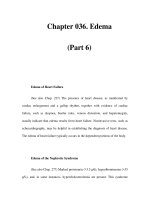Chapter 049. Sexual Dysfunction (Part 6) ppsx
Bạn đang xem bản rút gọn của tài liệu. Xem và tải ngay bản đầy đủ của tài liệu tại đây (80.13 KB, 5 trang )
Chapter 049. Sexual
Dysfunction
(Part 6)
Intraurethral Alprostadil
If a patient fails to respond to oral agents, a reasonable next choice is
intraurethral or self-injection of vasoactive substances. Intraurethral prostaglandin
E
1
(alprostadil), in the form of a semisolid pellet (doses of 125–1000 µg), is
delivered with an applicator. Approximately 65% of men receiving intraurethral
alprostadil respond with an erection when tested in the office, but only 50% of
those achieve successful coitus at home. Intraurethral insertion is associated with a
markedly reduced incidence of priapism in comparison to intracavernosal
injection.
Intracavernosal Self-Injection
Injection of synthetic formulations of alprostadil is effective in 70–80% of
patients with ED, but discontinuation rates are high because of the invasive nature
of administration. Doses range between 1 and 40 µg. Injection therapy is
contraindicated in men with a history of hypersensitivity to the drug and in men at
risk for priapism (hypercoagulable states, sickle cell disease). Side effects include
local adverse events, prolonged erections, pain, and fibrosis with chronic use.
Various combinations of alprostadil, phentolamine, and/or papaverine are
sometimes used.
Surgery
A less frequently used form of therapy for ED involves the surgical
implantation of a semirigid or inflatable penile prosthesis. These surgical
treatments are invasive, associated with potential complications, and generally
reserved for treatment of refractory ED. Despite their high cost and invasiveness,
penile prostheses are associated with high rates of patient and partner satisfaction.
Sex Therapy
A course of sex therapy may be useful for addressing specific interpersonal
factors that may affect sexual functioning. Sex therapy generally consists of in-
session discussion and at-home exercises specific to the person and the
relationship. It is preferable if therapy includes both partners, provided the patient
is involved in an ongoing relationship.
Female Sexual Dysfunction
Female sexual dysfunction (FSD) has traditionally included disorders of
desire, arousal, pain, and muted orgasm. The associated risk factors for FSD are
similar to those in males: cardiovascular disease, endocrine disorders,
hypertension, neurologic disorders, and smoking (Table 49-2).
Table 49-2 Risk Factors for Female Sexual Dysfunction
Neurologic disease: stroke, spinal cord injury, Parkinsonism
Trauma, genital surgery, radiation
Endocrinopathies: diabetes, hyperprolactinemia
Liver and/or renal failure
Cardiovascular disease
Psychological factors and interpersonal relationship disorders: sexual
abuse, life stressors
Medications
Antiandrogens: cimetidine, spironolactone
Antidepressants, alcohol, hypnotics, sedatives
Antiestrogens or GnRH antagonists
Antihistamines, sympathomimetic amines
Antihypertensives: diuretics, calcium channel blockers
Alkylating agents
Anticholinergics
Epidemiology
Epidemiologic data are limited, but the available estimates suggest that as
many as 43% of women complain of at least one sexual problem. Despite the
recent interest in organic causes of FSD, desire and arousal phase disorders
(including lubrication complaints) remain the most common presenting problems
when surveyed in a community-based population.
